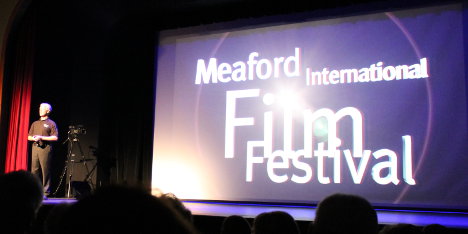By Bill Monahan
A breathy, poignant version of “Cry Me A River” performed on clarinet by flautist Roselyn Brown set the tone for the kickoff of the annual Meaford International Film Festival on Thursday night (September 3) as the last minute arrivals found their seats.
It had been filmed at this year’s Emancipation Festival in Owen Sound where photos of the 1965 Selma to Montgomery march had been originally displayed. These same photos were on exhibit at Meaford Hall to add to the impact of “Selma” the first film in the series.
A strong film, “Selma” went on to score highest as the audience choice, winning this year’s “Pomme D’or”. I can’t help but wonder if the award will end up on producer Oprah Winfrey’s desk and, if it does, will she ask, as have so many before her, “Where the heck is Meaford?”
Some context was provided by the on-stage interview after the film with Toronto writer Desmond Cole. The main theme of the artfully tailored “Selma” centred on the way a small town Alabama preacher was able to use his ability to manipulate media to bring pressure on the U.S. president into taking concrete action. The film, as expected, put mid-sixties racism in a glaring and ugly light. We were moved and offended, as we should be, by the hatred and ignorance of systemic racism but, until Cole took the stage, we could we could take comfort in the idea that it is something ingrained in American society while we enlightened Canadians are above such things. Cole has the manners and accent of others born and raised here, with a certain understated humanity and intelligent understanding of the world, but he articulated very clearly that, because his Canadian skin is black, he is not treated the same as white Canadians. It was a bit of a shock to hear that he has been “carded” in Toronto more than fifty times, and is followed by security when he browses in high end retail stores. It’s this added context, the enlarging of our perspective, which is one of the greatest gifts we are given by MIFF.
Interestingly, the context of the interviews that followed Friday night’s film, “Red Army” kind of turned it on its head, with a duo of commentators pointing out that what seemed an heroic resistance to totalitarianism on the part of Soviet hockey players was an illusion, given that after a taste of life in North America most of them returned home and some accepted major roles in the current government under the control of Putin.
But the real beauty of “Red Army”, as well as of the final film, “Speed Sisters” was in its celebration of the well-played game by talented players born to the role. In “Red Army” there were clips of the “Russian Five” in action, beautifully executed hockey where they pass the puck between them like a pinball game, skating circles around the other team. It was a style that worked in Olympic competition but couldn’t stand up against the North American emphasis on physical assault. And it was only possible because of the prison camp conditions in which these five players came of age, learning to read each others minds at top speed. The top speed displayed by the race car drivers in “Speed Sisters” was an exhibition of the same kind of ballet, although in this case they were a team in name only and in reality the “Speed Sisters” was about how they competed more with each other than with the male racers.
It wasn’t the film we’d expected to see, about five women competing in a man’s sport in Palestine. Instead of the anticipated oppression from an Islamist state denying women their rights, we saw how they were encouraged and celebrated for their talent and public appeal. Except when tucked into their helmets their long hair flowed freely and there was no sign of censure from their neighbours. Israeli occupation, though dramatic and at times violent, was only a backdrop to the story, which was more about celebrating achievement and community in a difficult situation. It was also about women, not in terms of their treatment by men but in terms of competition between them. Men are background characters in this story. The four racers and their team manager, as well as most of the documentary crew, are independent, strong and happy to be women. As things turn out feelings are tense between the “sisters” because every one wants to be a winner and there seems to be some favouritism on the part of the “federation” in favour of Betty. She is, in addition to being a skilled driver, beautiful by her own admission. She is proud to be so attractive and happy to become the celebrity that represents female car racing in Palestine. She has brand value for the sport and the country, and the less beautiful but equally skilled Marah seems to be kept from overturning her championship by arbitrary and unfair decisions against her. In that sense the story could have been set anywhere, and that’s what makes the film so surprising. Upsetting our preconceptions is clearly one of the aims of festival artistic director Christopher Thomas.
His stated aim, as he pronounced from the stage, is to allow us under the skin of the characters in the films, and that was most successfully accomplished by the third night’s film, “A Brilliant Young Mind”. It is the only film in the series that is entirely fiction, which gives it the flexibility to explore a theme to suit the filmmaker’s ends. We’ve seen stories before about what used to be called the “idiot savant” and now goes by several labels under the general heading of autism. The protagonist and narrator of this film is a young boy who has exceptional abilities that are expressed through mathematics but is cripplingly shy and cannot connect with others, to the extent that he recoils from anyone’s touch. The surprise here is that the real story is not about the boy, but it is about his mother’s heartbreaking inability to connect with him. She doesn’t have autism but her loneliness far surpasses his. The film does touch on how difficult it is to be in the boy’s situation, not so much through Nathan, the main character, as through Luke, a relative minor character, whose social abilities are so stunted that he can only hate himself. It is a love story that opens up the viewer’s heart as it does Nathan’s when our emotions are invested in the mother’s sad plight. The context for this film was suitably provided, not by interviews, which only could have diluted the emotional impact, but by the filmed poem by young local filmmaker Gillian Wagenaar. Aptly titled “Skin City” it was all abstract emotion conveying the outsider’s sensibility from a filmmaker whose age mirrored that of the main film’s protagonist.
This and other films by local teenagers, which opened the show every night, chosen from participants in the Grey Bruce Youth Film Festival, added another level of delight to MIFF, as they do every year. What happens if you assign the task of making a short film to someone with no experience, very limited resources and limitless imagination? You get pure film in the sense that it is a visual expression that is direct and true. The youth films that begin each night at MIFF are bright lights of inspiration and daring in a medium that can be so very heavily structured. Seeing the filmmakers themselves interviewed on stage, simultaneously awkward and proud, adds a whole dimension to the community experience.
Of course the dinners beforehand and the after-party, the trivia questions and gourmet canapés, the enthusiasm of so many community volunteers, all contribute to make this film series a uniquely memorable experience every year. Like so many things that happen here in Meaford, it resonates with a love of life and expression. We are so lucky to have it in our little town.












